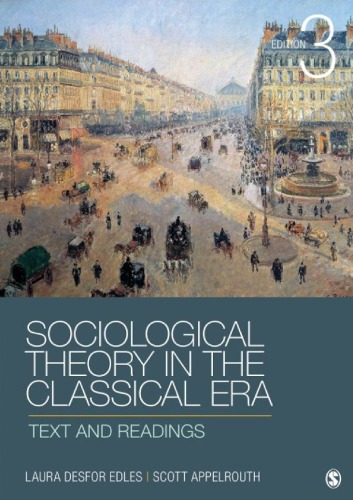(Ebook) Sociological Theory in the Classical Era: Text and Readings by Laura Desfor and Scott Appelrouth ISBN 9781452203614, 145220361X
Every semester, we begin our sociological theory courses by tellingstudents that we love sociological theory, and that one of our goals isto get each and every one of them to love theory too. This challengewe set for ourselves makes teaching sociological theory exciting. Ifyou teach “sexy” topics like the sociology of drugs, crime, or sex, studentscome into class expecting to be titillated. By contrast, when you teachsociological theory, students tend to come into class expecting the course tobe abstract, dry, and absolutely irrelevant to their lives. The fun in teachingsociological theory is in proving students wrong. The thrill in teachingsociological theory is in helping students to see that sociological theory isabsolutely central to their everyday lives—and fascinating as well. What areward it is to have students who adamantly insisted that they “hated” theoryat the beginning of the semester be “converted” into theorists by the end!In teaching sociological theory, we use original texts. We rely on originaltexts in part because every time we read these works we derive new meaningfrom them. Core sociological works tend to become “core” precisely for thisreason. However, using original readings requires that the professor spend lotsof time and energy explaining issues and material that is unexplained or takenfor granted by the theorist. This book was born of this process—teachingfrom original works and explaining them to our students. Hence, this bookincludes the original readings we use in our courses, as well as ourinterpretation and explanation of them.Thus, this book is distinct in that it is both a reader and a text. It is unlikeexisting readers in several ways, however. First and foremost, this book is notjust a collection of seemingly disconnected readings. Rather, in this book weprovide an overarching theoretical framework within which to understand,compare, and contrast these selections. In our experience, this overarchingtheoretical framework is essential in explaining the relevance and excitementof sociological theory.In addition, we discuss the social and intellectual milieu in which theselections were written, as well as their contemporary relevance. Thus, weconnect these seemingly disparate works not only theoretically, but also viaconcrete applications to today’s world.Finally, this theory book is unique in that we provide a variety of visualsand pedagogical devices—historical and contemporary photographs, anddiagrams and charts illuminating core theoretical concepts and comparingspecific ideas—to enhance student understanding. Our thinking is, Whyshould only introductory-level textbooks have visual images and pedagogicalaids? Most everyone, not just the youngest audiences, enjoys—and learnsfrom—visuals.The third edition of this book is distinct in that it includes even more visualelements, contemporary applications, and examples. It also includesadditional discussion questions as well as a glossary to assist students infamiliarizing themselves with the key terms.
*Free conversion of into popular formats such as PDF, DOCX, DOC, AZW, EPUB, and MOBI after payment.


